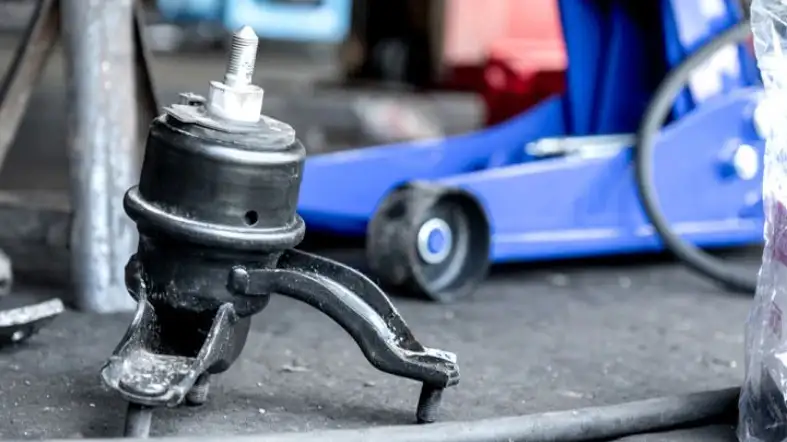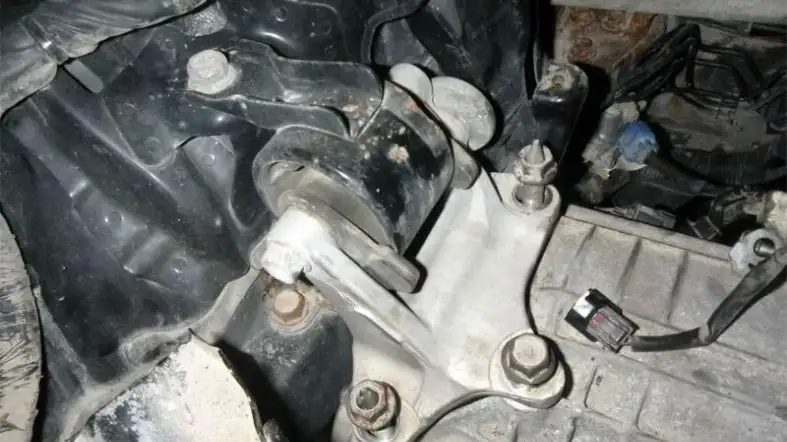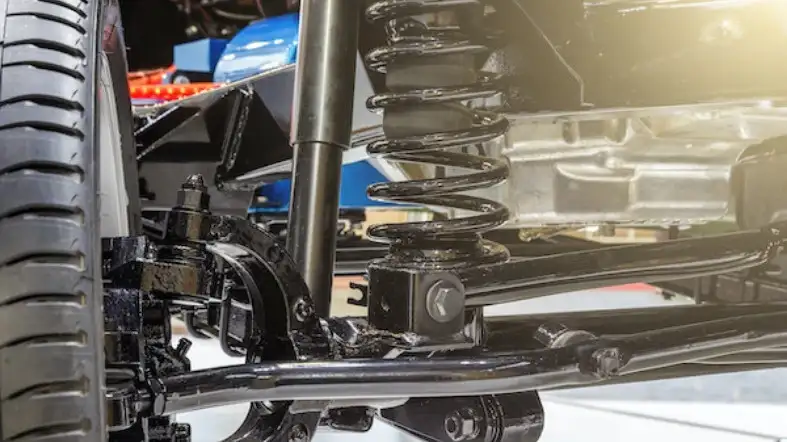Curious about the impact of bad engine mounts on your vehicle’s transmission?
In this article, we’ll explore the vital role engine mounts play in your car’s performance.
Discover how deteriorating engine mounts can lead to transmission issues, including misalignment, fluid leaks, increased wear, harsh shifting, and reduced fuel efficiency.
Stay informed to ensure a smooth and safe driving experience. Can bad engine mounts affect the transmission? Find out here.

Can Bad Engine Mounts Affect The Transmission?
Yes, bad engine mounts can affect the transmission. When engine mounts fail, it can lead to excessive engine movement, which may cause misalignment with the transmission. This can result in transmission issues like rough shifting and potential damage over time. Regular maintenance is crucial to prevent such problems.
The Connection Between Engine Mounts and Transmission
The connection between engine mounts and transmissions is a crucial aspect of vehicle design and performance.
Engine mounts are essential components that secure the engine to the vehicle’s frame while allowing for some degree of movement.
This connection directly impacts the structural integrity of the vehicle as well as its overall functionality.
It plays a pivotal role in dampening vibrations generated by the engine, ensuring efficient power transmission from the engine to the transmission, and safeguarding against excessive wear and tear.
The choice of materials for engine mounts, along with proper maintenance, contributes to the vehicle’s longevity and reliability.
Additionally, this connection has implications for noise reduction and safety considerations, making it a critical element in the design and operation of automobiles.
How Bad Engine Mounts Impact Transmission

Let’s explore how bad engine mounts impact transmission:
Misalignment
As engine mounts deteriorate, they may no longer hold the engine firmly in place.
This can lead to engine misalignment, causing the engine and transmission to move out of sync. As a result, you may experience difficulties shifting gears smoothly.
Transmission Fluid Leaks
Excessive vibrations caused by bad engine mounts can potentially damage the seals within the transmission.
This can result in fluid leaks, which are detrimental to the transmission’s lubrication and cooling. Without proper fluid levels, the transmission can overheat and eventually fail.
Increased Wear and Tear
Vibrations transmitted to the transmission can accelerate wear and tear on its components.
This can lead to premature transmission failure and necessitate costly repairs.
Harsh Shifting
When engine and transmission misalignment occurs due to bad engine mounts, you may notice harsh and jerky shifts while driving.
Reduced Fuel Efficiency
Inefficient engine mounts can also affect your vehicle’s overall performance, including fuel efficiency.
When the engine doesn’t operate optimally, it can lead to increased fuel consumption.
These consequences underscore the importance of maintaining healthy engine mounts to ensure the longevity and smooth operation of your vehicle’s transmission.
Can A Bad Battery Cause Reduced Engine Power? (Explained)
Signs and Symptoms of Worn Engine Mounts
Vibrations and Noise
When engine mounts wear out, you will feel vibrations. These vibrations are very noticeable. They can be felt on the steering wheel.
The vibrations can also be felt on the floorboard. Another sign is noise. The noise is a clunking or banging sound.
It happens when the engine moves. This sound is often loud. It is different from normal engine sounds.
Reduced Engine Performance
Worn engine mounts affect engine performance. The engine may not work as it should.
You might notice a decrease in power. Acceleration might be slower. The vehicle might struggle to climb hills.
All these signs point to reduced engine performance. This is a clear sign of worn engine mounts.
Misaligned Components
Engine mounts hold the engine in place. When they are worn, components can misalign.
This means parts of the engine are not in the right place. This misalignment can cause other parts to wear out quickly.
It affects the vehicle’s operation. Misalignment is a serious sign of worn engine mounts.
Uneven Tire Wear
Uneven tire wear is another symptom. Worn engine mounts lead to misalignment. This affects wheel alignment.
When wheel alignment is off, tires wear unevenly. One side may wear out faster than the other. This is dangerous. It affects the vehicle’s stability on the road.
Increased Fuel Consumption
Worn engine mounts can lead to increased fuel consumption. When engine mounts are worn, the engine works harder.
This requires more fuel. You might notice you are filling up the gas tank more often. This is a clear sign of increased fuel consumption due to worn engine mounts.
Transmission Issues
Transmission issues can also occur. The transmission and engine are connected. When engine mounts wear out, the transmission can misalign.
This misalignment can cause shifting problems. The vehicle might jerk during gear changes. It might also make unusual noises.
These are signs of transmission issues due to worn engine mounts.
Engine Movement
Engine movement is a clear sign. The engine should not move much when the vehicle is running.
If engine mounts are worn, the engine will move. This movement can be side to side. It can also be up and down.
If you notice the engine moving, it’s a sign. The engine mounts are likely worn out.
The Role of Engine Mounts in Vehicle Performance

A well-maintained engine mount system ensures:
Smooth Ride
Engine mounts help provide a smooth ride. They connect the engine to the car frame.
This stops vibrations from reaching the passengers. When the engine runs, it creates vibrations.
Engine mounts stop these vibrations from moving to the car’s frame. A smooth ride means more comfort for passengers. It also means less wear and tear on the car.
Enhanced Handling
Handling refers to how well a car responds to the driver’s inputs. Good engine mounts lead to enhanced handling.
They make sure the engine stays in place. This is important when the car is turning or facing bumps. When the engine is stable, the car responds better.
This makes the car safer. It also makes driving more enjoyable. Drivers find it easier to control the car. This is vital to avoiding accidents.
Noise Reduction
Engine mounts are key in noise reduction. They reduce noise from the engine reaching the cabin.
They do this by absorbing vibrations and sounds. This makes the ride quieter for passengers.
A quiet ride lets passengers talk easily. It also reduces stress during travel. Noise can be disturbing.
Engine mounts help in making travels peaceful. This is crucial for long drives and heavy traffic.
Longevity
The longevity in terms of durability of engine mounts and a car body. Good engine mounts make vehicles live longer.
These absorb shocks and thus mitigate additional stress on vehicle parts. Components with low stress last long.
A car with longer last will be much better in reliability. This further reduces cost over the long-term. This is due to less repairs required. Another advantage is that it requires less frequent replacements.
Efficiency and Fuel Consumption
The efficiency and fuel consumption are closely dependent on the engine mounts. They ensure the engine is aligned rightfully.
When it is properly aligned engine works much better. Less fuel is used to use an efficient engine.
It is good for the environment. It also means reduced fuel bills. Today, using less fuel is important.
It is an environmental friendly approach as well as a preservative. It is crucial for sustainability of life.
Comparing Good vs. Bad Engine Mounts’ Impact on Transmission
Let’s dive into a detailed comparison of how good engine mounts differ from bad ones and their respective impacts on your vehicle’s transmission:
| Impact | Good Engine Mounts | Bad Engine Mounts |
|---|---|---|
| Vibration | Good engine mounts reduce the vibration from the engine and transmission and isolate them from the vehicle frame. This improves the comfort and performance of the vehicle. | Bad engine mounts allow excessive vibration to transfer to the vehicle frame and the cabin. This can cause noise, discomfort, and damage to other components. |
| Alignment | Good engine mounts keep the engine and transmission in proper alignment with each other and with the drivetrain. This ensures smooth and efficient power delivery. | Bad engine mounts can cause the engine and transmission to shift or sag out of alignment. This can result in poor power delivery, increased wear and tear, and potential leaks or damage to the drivetrain. |
| Shifting | Good engine mounts allow smooth and precise shifting of gears by the transmission. This enhances the performance and fuel economy of the vehicle. | Bad engine mounts can cause harsh or delayed shifting of gears by the transmission. This can affect the performance and fuel economy of the vehicle, as well as cause stress and damage to the transmission. |
| Stability | Good engine mounts provide stability and support to the engine and transmission under various driving conditions. This helps in maintaining optimal balance and handling of the vehicle. | Bad engine mounts can compromise the stability and support of the engine and transmission under various driving conditions. This can lead to excessive movement or bouncing of the engine and transmission, which can affect the balance and handling of the vehicle. |
| Safety | Good engine mounts ensure the safety of the engine and transmission by preventing them from coming loose or falling off the vehicle frame. This protects the driver and passengers from potential hazards. | Bad engine mounts pose a safety risk to the engine and transmission by allowing them to come loose or fall off the vehicle frame. This can create dangerous situations for the driver and passengers, as well as other road users. |
Importance of Timely Engine Mount Replacement
Know why timely engine mount replacement is so important:
Minimizing Vibration
The vibrations produced by the engine are dampened through the use of engine mounts. As time passes, the mounts wear out, which results in an increased amount of vibration getting to the cabin of the vehicle.
This not only results in an uncomfortable and noisy journey but may also affect various vehicle components.
Protecting Other Parts
Misalignment of the engine and transmission can also occur with worn-out engine mounts.
When these two major components are not properly aligned problems with gear shifting can arise and even damage transmission itself.
These critical parts can be properly aligned by simply changing the mounts.
Extending Transmission Life
The extra stress is brought by a vibrating engine on the transmission. Eventually, such strain may result in early failure of transmission components, which could be expensive to fix or even replace.
If you replace the engine mounts quickly, then your transmission will last longer and you’ll get fewer repairs.
Enhancing Driving Experience
Good engine mounts ensure that your vehicle runs smoothly and quietly. They also contribute to smoother gear shifts.
When you replace worn-out engine mounts, you’ll notice an immediate improvement in your driving experience, with reduced noise, vibration, and harshness.
Preventing Further Damage
Neglecting worn engine mounts can have a domino effect on other vehicle parts. Vibrations can damage exhaust systems, suspension components, and more.
By replacing engine mounts when needed, you prevent such collateral damage, ultimately saving you money on extensive repairs.
The importance of timely engine mount replacement cannot be overstated. It helps minimize vibrations, protects crucial vehicle components, extends the life of your transmission, enhances your driving experience, and prevents further damage to your vehicle.
Regular inspections and prompt replacements ensure that your vehicle operates smoothly, quietly, and efficiently.
FAQs about bad engine mounts affecting the transmission:
Can You Drive A Car With Bad Engine Mounts?
Yes, you can. But as it affects the transmission system, driving the car is a very dangerous task and may lead to serious consequences.
Can Motor Mounts Cause The Transmission To Slip?
Motor mounts affect the shift linkage by misadjusting it or stretching it badly. Due to this, the manual transmission may slip out at any time.
How Much Does Engine Mount Replacement Cost?
It doesn’t cost too much. Including the price for bolts, the cost may vary between $75 to $225.
Should I Replace All Engine Mounts At Once?
You don’t have to replace all the engine mounts at the same time. But you should keep an eye on those that you think are still in good condition.
Do bad engine mounts affect fuel efficiency?
Yes, bad engine mounts can affect fuel efficiency by causing the engine to operate inefficiently and leading to increased fuel consumption.
Are engine mounts important for vehicle safety?
Yes, engine mounts play a role in vehicle safety by preventing the engine and transmission from coming loose, which can pose hazards to the driver, passengers, and other road users.
Final Words
Worn out engine mounts can result in misalignment, fluid leaks, increased wear, harsh shifting, and reduction of fuel efficiency.
The maintenance and replacement of parts are essential for a safe journey.
Don’t forget these unsung heroes, as they hold everything together that keeps your car on top, thus guaranteeing a secure and comfortable journey on the road.
